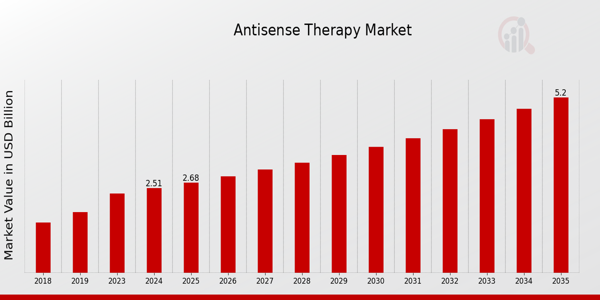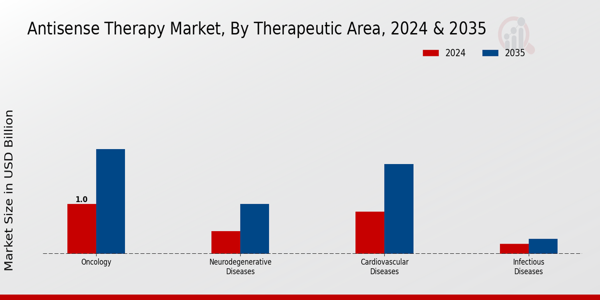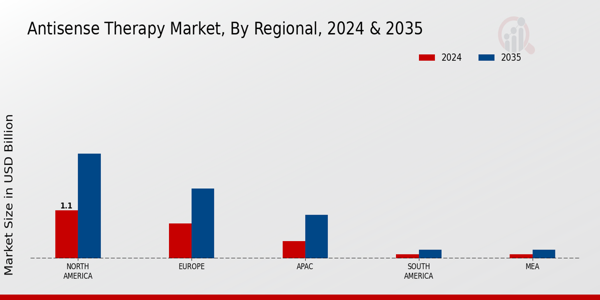Antisense Therapy Market Overview
As per MRFR analysis, the Antisense Therapy Market Size was estimated at 2.35 (USD Billion) in 2023. The Antisense Therapy Market Industry is expected to grow from 2.51(USD Billion) in 2024 to 5.2 (USD Billion) by 2035.
The Antisense Therapy Market CAGR (growth rate) is expected to be around 6.86% during the forecast period (2025 - 2035).
Key Antisense Therapy Market Trends Highlighted
The Global Antisense Therapy Market is undergoing significant trends as a result of the growing demand for targeted treatments and the advancements in genetic research. Research in antisense oligonucleotides (ASOs) as innovative therapeutic options has been accelerated by the increasing prevalence of genetic disorders and malignancies, which is one of the primary market drivers.
Globally, countries are emphasizing personalized medicine, which encourages the creation of therapies that are customized to the unique genetic profiles of each patient, thereby improving the efficacy of treatment. The ongoing support for the research and development of antisense therapies from governmental health agencies and funding entities is indicative of a strong dedication to this field. The Global Antisense Therapy Market presents a plethora of opportunities, particularly as emerging technologies like CRISPR and RNA interference acquire momentum.
These technologies offer optimistic opportunities for the further development of antisense therapies, which could potentially result in breakthroughs in the treatment of previously challenging ailments. The collaborations between pharmaceutical companies and academic institutions will probably generate novel opportunities for the commercialization and innovation of antisense therapies. Recent trends suggest a transition to combination therapies that include antisense oligonucleotides as part of multi-drug regimens, thereby improving the therapeutic outcomes of patients.

Source: Primary Research, Secondary Research, MRFR Database and Analyst Review
Antisense Therapy Market Drivers
Rising Incidence of Genetic Disorders
The Global Antisense Therapy Market Industry is being significantly driven by the rising incidence of genetic disorders worldwide. According to the World Health Organization (WHO), an estimated 1 in 1,600 individuals is affected by a genetic disorder, amounting to approximately 300 million people globally. This staggering number of patients highlights the pressing need for innovative therapeutic solutions. Organizations such as the National Institutes of Health (NIH) and various genetic disorder advocacy groups are actively promoting research initiatives in genetic therapies, which also include antisense therapies.
As these organizations catalyze efforts in research and knowledge dissemination, the market is expected to experience a robust growth in demand for treatment modalities targeting genetic disorders.
Advancements in Biotechnology
Innovations within the biotechnology sector are acting as a critical driver for the Global Antisense Therapy Market Industry. The development of novel antisense oligonucleotides has seen exponential growth, bolstered by increasing funding in Research and Development from key players like Roche and Ionis Pharmaceuticals. The Biotechnology Innovation Organization (BIO) reported a significant 30% increase in biotechnology patents related to antisense technologies over the past five years.
Such advancements not only enhance the efficacy of therapies but also broaden their applications across different therapeutic areas, creating a favorable environment for market expansion.
Growing Demand for Personalized Medicine
The trend towards personalized medicine is another prominent driver of the Global Antisense Therapy Market Industry. Recent studies indicate that customized medicine could lead to cost reductions of up to 30% in drug development by targeting specific patient populations more effectively. The Personalized Medicine Coalition, a key organization in this field, advocates for the integration of personalized therapy approaches, including antisense therapies.
The increasing recognition of unique genetic profiles and the effectiveness of tailored therapies in improving patient outcomes are likely to amplify market growth in the coming years.
Supportive Government Policies and Funding
Supportive government policies globally bolster the Global Antisense Therapy Market Industry. Numerous countries are ramping up their investment in biotechnology and genetic research initiatives. For instance, the National Institutes of Health's budget proposal for the 2024 fiscal year indicated an increase in funding for genetic research by 5%, emphasizing the government's dedication to combating genetic diseases through advanced therapies like antisense strategies.
This financial support encourages innovation and can lead to faster development timelines for antisense therapy products, which is crucial for meeting patient needs.
Antisense Therapy Market Segment Insights
Antisense Therapy Market Therapeutic Area Insights
The Global Antisense Therapy Market within the Therapeutic Area segment is experiencing significant growth, highlighting its increasing relevance in modern medicine. The overall market is projected to reach a valuation of 2.51 USD Billion in 2024, showcasing a solid foundation for future development. By 2035, this market is expected to expand impressively to 5.2 USD Billion, driven by advancements in technology and a growing understanding of disease mechanisms.
Among the various segments within the Therapeutic Area, Oncology dominates significantly, holding a valuation of 1.0 USD Billion in 2024 and projected to rise to 2.1 USD Billion by 2035. This substantial growth reflects the pressing need for innovative cancer therapies, as cancer remains one of the leading causes of mortality worldwide.
Following closely is the segment for Cardiovascular Diseases, valued at 0.85 USD Billion in 2024, with projections showing an upward trajectory to 1.8 USD Billion in 2035. Cardiovascular diseases are a major global health risk, and the rising emphasis on targeted treatments is likely to propel this segment further. Neurodegenerative Diseases, while relatively smaller, hold an essential place in market dynamics, valued at 0.46 USD Billion in 2024 and expected to reach 1.0 USD Billion by 2035. This growth reflects the increasing recognition of neurodegenerative disorders like Alzheimer's and Parkinson's disease as critical areas where antisense technologies can offer novel treatment approaches.
Lastly, the segment for Infectious Diseases is the least valued at 0.2 USD Billion in 2024, but it is projected to grow modestly to 0.3 USD Billion by 2035, indicating a targeted focus to address both emerging and re-emerging infections. This segmentation showcases the Global Antisense Therapy Market is poised for extensive growth, with substantial opportunities attributed to innovation, increased spending on healthcare, and a broader acceptance of novel therapeutic strategies.
The data reveals a clear market growth trajectory, demonstrating varying degrees of importance across different therapeutic areas, underscoring the need for targeted Research and Development efforts to maximize the efficacy of antisense therapies in addressing critical healthcare challenges. Given these dynamics, the Global Antisense Therapy Market presents a compelling landscape for stakeholders looking to invest in pioneering treatment solutions aimed at improving patient outcomes.

Source: Primary Research, Secondary Research, MRFR Database and Analyst Review
Antisense Therapy Market Type of Product Insights
The Global Antisense Therapy Market is poised for significant growth, with a valuation expected to reach 2.51 USD Billion in 2024. This market encompasses various types of products, including Nucleotides, Oligonucleotides, and Gene Silencing Products. Nucleotides play a crucial role in the synthesis and function of nucleic acids, making them vital for therapeutic applications. Oligonucleotides are highly important due to their ability to specifically target and inhibit the expression of genes associated with numerous diseases, thus driving innovation in treatment strategies.
Gene Silencing Products are increasingly recognized for their potential to regulate gene expression, offering extensive applications in the treatment of genetic disorders. As the Global Antisense Therapy Market continues to expand, product innovations, favorable regulatory frameworks, and a growing understanding of genetic diseases are key factors promoting market growth.
However, challenges related to delivery methods and potential side effects remain pertinent. Opportunities in the market are presented through ongoing Research and Development efforts and collaborations aimed at enhancing the effectiveness and accessibility of these therapies.
Insights from market data project a robust trajectory towards a valuation of 5.2 USD Billion by 2035, reflecting the expansive potential of the market.
Antisense Therapy Market Route of Administration Insights
The Global Antisense Therapy Market, particularly regarding the Route of Administration segment, showcases significant diversity in delivery methods that cater to varying patient needs and treatment protocols. By 2024, the overall market is projected to reach a valuation of 2.51 billion USD, growing to an estimated 5.2 billion USD by 2035. Among the various routes, Intravenous administration is often favored for its rapid onset of action and high bioavailability, which is essential in treating severe conditions. Subcutaneous methods present an advantage due to their ease of administration, making them preferable for outpatient scenarios and enhancing patient compliance.
Oral administration, while traditionally challenging in terms of bioavailability, is gaining traction with recent advances in formulation technology. The predominance of these administration routes illustrates their critical role in the therapeutic success of antisense therapies. The Global Antisense Therapy Market data reflects ongoing efforts to innovate in this area, driven by trends toward personalized medicine and the increasing emphasis on patient-centered care. A comprehensive understanding of the Global Antisense Therapy Market statistics concerning these routes can illuminate growth drivers, including advances in drug delivery technologies and changing healthcare landscapes.
However, challenges, such as regulatory hurdles and varying patient responses, continue to shape the conversation around this market segment.
Antisense Therapy Market End User Insights
The Global Antisense Therapy Market is witnessing significant growth driven by its diverse end-user landscape, which includes Hospitals, Research Laboratories, and Pharmaceutical Companies. In 2024, the market is projected to be valued at 2.51 billion USD, reflecting the increasing adoption of antisense therapies across various sectors.
Hospitals play a crucial role in the administration and integration of these therapies into healthcare protocols, providing vital treatments to patients with chronic diseases. Research Laboratories are essential for innovation and development, fostering advancements that contribute to the broader understanding of antisense mechanisms and their potential applications.
Pharmaceutical Companies are pivotal in the mass production and commercialization of antisense drugs, driving competition and innovation within the industry. The sector is characterized by ongoing research and development efforts, which are crucial for addressing diseases that currently lack effective therapies.
As the Global Antisense Therapy Market continues to expand, each of these End Users will remain a fundamental contributor, helping to shape the market's future trajectory and addressing the growing demand for targeted therapies in the healthcare landscape.
Antisense Therapy Market Regional Insights
The Global Antisense Therapy Market showcases significant regional variations, with North America leading the market, valued at 1.1 USD Billion in 2024 and projected to increase to 2.4 USD Billion by 2035, demonstrating its majority holding in the overall market. This region’s dominance is attributed to advanced healthcare infrastructure and substantial investment in Research and Development.
Europe follows, having a valuation of 0.8 USD Billion in 2024, set to reach 1.6 USD Billion in 2035, indicating its important role in the global landscape through robust regulatory frameworks and increasing focus on personalized medicine.
The Asia-Pacific (APAC) region is expected to experience noteworthy growth, rising from 0.4 USD Billion in 2024 to 1.0 USD Billion in 2035.
This presents opportunities driven by increasing patient populations and expanding healthcare access. South America and the Middle East and Africa (MEA) both show lower figures, starting at 0.1 USD Billion in 2024 and projected to reach 0.2 USD Billion by 2035, reflecting the emerging markets’ potential but highlighting challenges such as limited healthcare expenditure and infrastructure development.
Overall, these regional dynamics reflect diverse growth opportunities and challenges within the Global Antisense Therapy Market segmentation.

Source: Primary Research, Secondary Research, MRFR Database and Analyst Review
Antisense Therapy Market Key Players and Competitive Insights
The Global Antisense Therapy Market is characterized by rapid development and increasing competitive dynamics as various stakeholders strive to capitalize on the potential of this innovative therapeutic area. Antisense therapies are emerging as pivotal solutions for a variety of diseases, particularly genetic disorders and cancers, where conventional treatments have often fallen short.
The market is marked by the presence of both established pharmaceutical giants and emerging biotech companies, each vying to advance their antisense drug candidates through rigorous research and development efforts. Collaborations, strategic partnerships, and intense competition for intellectual property rights are also significant elements shaping the landscape of this market, as stakeholders seek to bring their antisense therapies from the lab to clinical use effectively.
Ionis Pharmaceuticals holds a prominent position in the Global Antisense Therapy Market primarily due to its pioneering work in the field of RNA-targeted drug discovery. The company has developed a robust pipeline of antisense oligonucleotide therapies, which provide a unique advantage over traditional small molecule drugs by enabling precise targeting of disease-causing genes. With a strong emphasis on innovation and a commitment to advancing its proprietary technology platforms, Ionis Pharmaceuticals benefits from several strategic alliances and partnerships that facilitate its research initiatives and enhance its market presence.
The company's proven track record in drug development, including the successful commercialization of its therapies, reinforces its competitive strength and positions it well for future growth in this rapidly evolving sector.
CureVac has emerged as a noteworthy player in the Global Antisense Therapy Market, with a distinct focus on mRNA-based therapies that align with antisense technology principles. The company is known for its innovative approach to leveraging mRNA for vaccine and therapeutic applications, which has garnered attention due to its potential to address a wide range of diseases.
CureVac's offerings include a diverse portfolio of product candidates that harness the power of messenger RNA to modulate gene expression. The company has engaged in strategic collaborations and partnerships that not only bolster its research capacity but also expand its therapeutic footprint on a global scale. CureVac's strengths lie in its extensive research initiatives, robust pipeline, and commitment to enhancing drug delivery mechanisms, all of which contribute to its competitive advantage in the Global Antisense Therapy Market.
In the wake of recent mergers and acquisitions, the company is positioned to diversify its product offerings further while maintaining a strong presence in the sector driven by its innovative technology.
Key Companies in the Antisense Therapy Market Include
- Ionis Pharmaceuticals
- CureVac
- Thermo Fisher Scientific
- Takeda Pharmaceuticals
- Regulus Therapeutics
- Roche
- Bristol Myers Squibb
- Biogen
- Eisai
- Sarepta Therapeutics
- Wave Life Sciences
- Novartis
- Bayer
- Merck
- AstraZeneca
Antisense Therapy Market Industry Developments
The Global Antisense Therapy Market has seen significant developments recently, with Ionis Pharmaceuticals leading the charge with advancements in its drugs targeting neurodegenerative diseases.
In July 2023, CureVac announced a partnership with Roche to develop mRNA therapies that could complement antisense technologies. Similarly, in August 2023, Takeda Pharmaceuticals expanded its antisense research through a collaboration with Wave Life Sciences focused on rare genetic disorders. Mergers and acquisitions have also shaped the market landscape; for instance, Bristol Myers Squibb's acquisition of MyoKardia in November 2022 has bolstered its presence in the cardiovascular segment of antisense therapies.
Additionally, Biogen's strategic collaboration with Eisai in late 2022 aims to leverage antisense technology for neurological disorders. The market is experiencing robust growth, evidenced by Novartis' reported valuation increase, which highlights the ongoing investment in antisense technology aimed at addressing unmet medical needs. Sustained interest from major pharmaceutical players such as Bayer and Merck further reflects the urgency to innovate within this domain.
Over the past few years, regulatory approvals have accelerated, influencing market dynamics positively and ensuring a rapid response to emerging medical demands.
Antisense Therapy Market Segmentation Insights
Antisense Therapy Market Therapeutic Area Outlook
- Oncology
- Cardiovascular Diseases
- Neurodegenerative Diseases
- Infectious Diseases
Antisense Therapy Market Type of Product Outlook
- Nucleotides
- Oligonucleotides
- Gene Silencing Products
Antisense Therapy Market Route of Administration Outlook
- Intravenous
- Subcutaneous
- Oral
Antisense Therapy Market End User Outlook
- Hospitals
- Research Laboratories
- Pharmaceutical Companies
Antisense Therapy Market Regional Outlook
- North America
- Europe
- South America
- Asia Pacific
- Middle East and Africa
| Report Attribute/Metric Source: |
Details |
| MARKET SIZE 2023 |
2.35(USD Billion) |
| MARKET SIZE 2024 |
2.51(USD Billion) |
| MARKET SIZE 2035 |
5.2(USD Billion) |
| COMPOUND ANNUAL GROWTH RATE (CAGR) |
6.86% (2025 - 2035) |
| REPORT COVERAGE |
Revenue Forecast, Competitive Landscape, Growth Factors, and Trends |
| BASE YEAR |
2024 |
| MARKET FORECAST PERIOD |
2025 - 2035 |
| HISTORICAL DATA |
2019 - 2024 |
| MARKET FORECAST UNITS |
USD Billion |
| KEY COMPANIES PROFILED |
Ionis Pharmaceuticals, CureVac, Thermo Fisher Scientific, Takeda Pharmaceuticals, Regulus Therapeutics, Roche, Bristol Myers Squibb, Biogen, Eisai, Sarepta Therapeutics, Wave Life Sciences, Novartis, Bayer, Merck, AstraZeneca |
| SEGMENTS COVERED |
Therapeutic Area, Type of Product, Route of Administration, End User, Regional |
| KEY MARKET OPPORTUNITIES |
Increasing prevalence of genetic disorders, Growing investment in RNA therapeutics, Expanding pipeline of antisense drugs, Advancements in delivery technologies, Rising adoption in oncology treatments |
| KEY MARKET DYNAMICS |
increasing prevalence of genetic disorders, growing investments in RNA-based therapies, advancements in drug delivery systems, rising demand for personalized medicine, supportive regulatory environment |
| COUNTRIES COVERED |
North America, Europe, APAC, South America, MEA |
Frequently Asked Questions (FAQ) :
The Global Antisense Therapy Market is expected to be valued at 2.51 USD Billion in 2024.
By 2035, the Global Antisense Therapy Market is projected to be valued at 5.2 USD Billion.
The market is expected to grow at a CAGR of 6.86% from 2025 to 2035.
Oncology is expected to have the largest market share, valued at 2.1 USD Billion by 2035.
The market for Cardiovascular Diseases is projected to be valued at 1.8 USD Billion in 2035.
In 2024, the North America market is valued at 1.1 USD Billion and is expected to reach 2.4 USD Billion by 2035.
The Asia-Pacific region is expected to reach a market size of 1.0 USD Billion by 2035.
Major players include Ionis Pharmaceuticals, CureVac, Thermo Fisher Scientific, and Takeda Pharmaceuticals among others.
The market for Neurodegenerative Diseases is projected to be valued at 1.0 USD Billion by 2035.
Challenges may include regulatory hurdles and competition from alternative therapies.


















